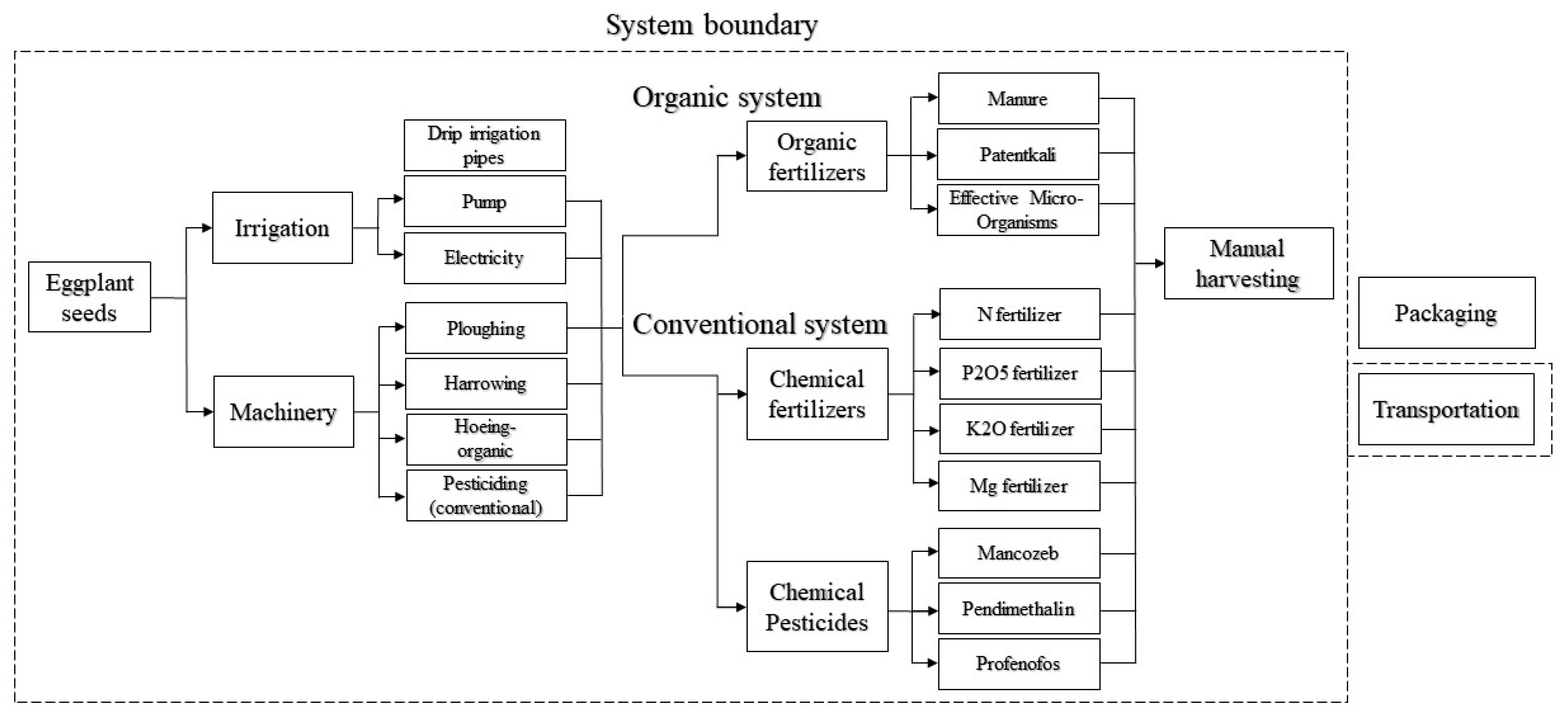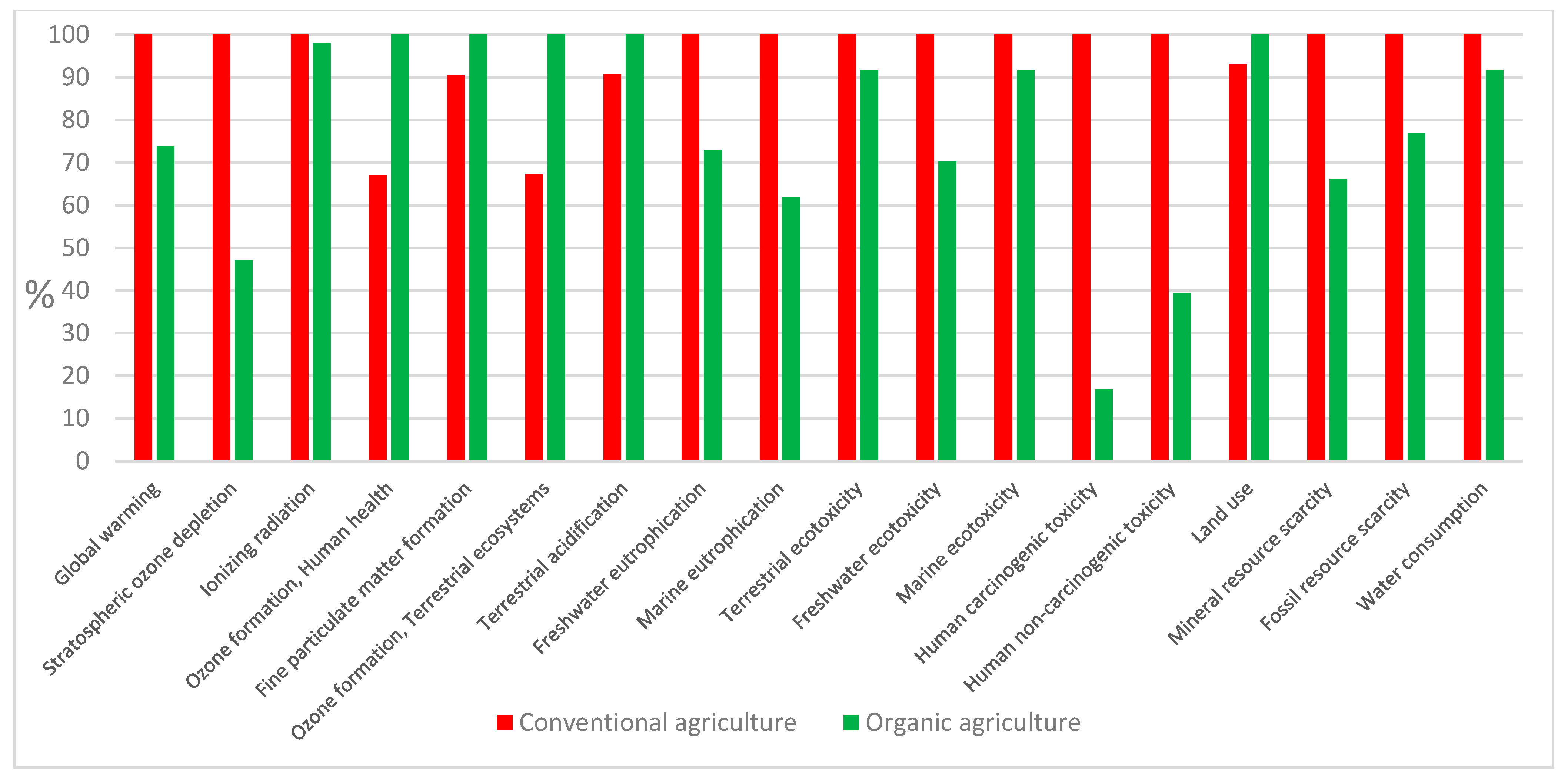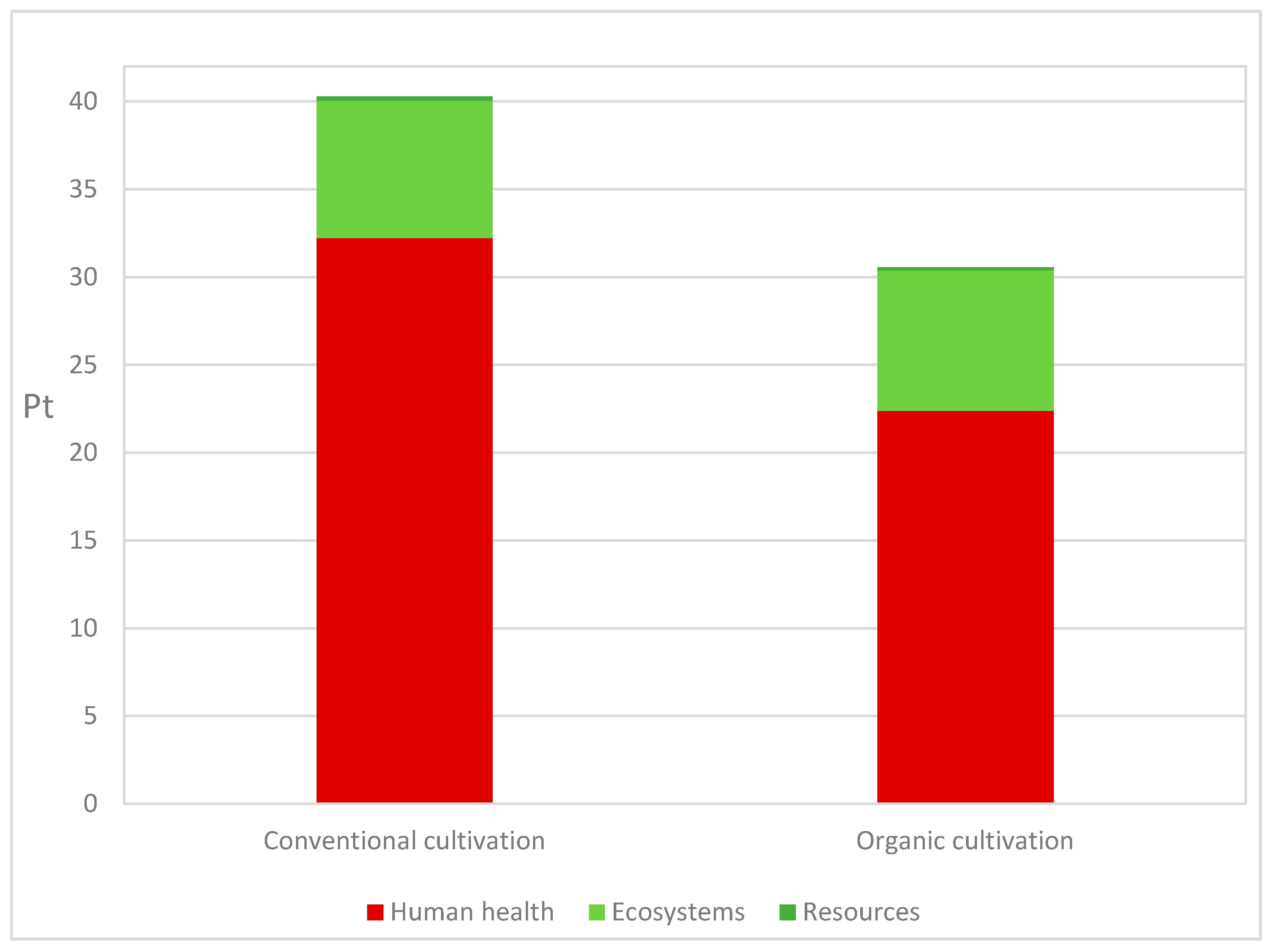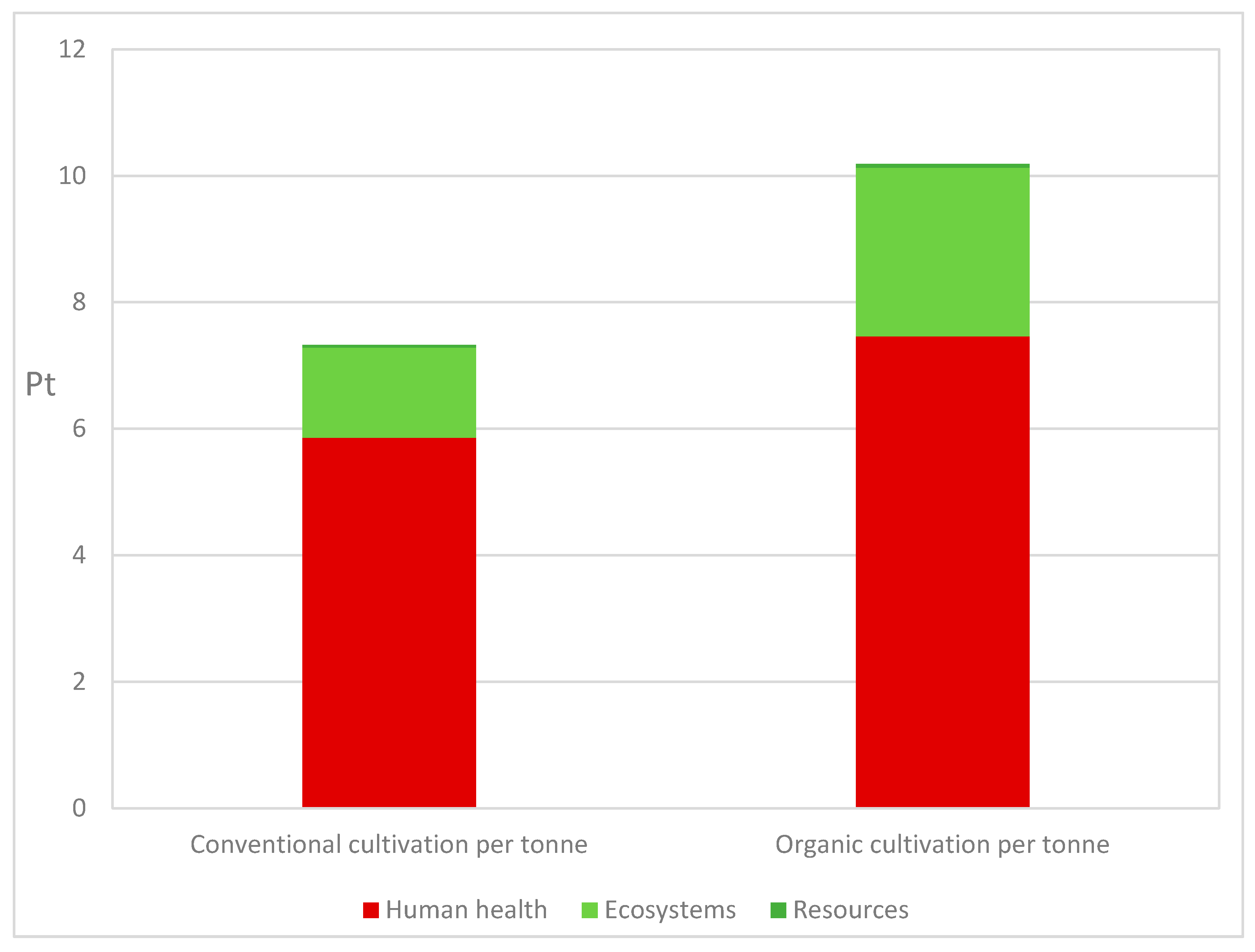Environmental Impacts of Conventional versus Organic Eggplant Cultivation Systems: Influence of Electricity Mix, Yield, Over-Fertilization, and Transportation
Abstract
1. Introduction
2. Methodology
2.1. Goal
2.2. System Boundary
- (a)
- Seedling growing. In practice, this is undertaken within greenhouses to ensure stable temperature and humidity conditions. Given that similar inputs are used in both cases, this process is excluded from the LCA boundary.
- (b)
- Seedling planting and eggplant harvesting. These are undertaken manually (no machinery or energy input) in both organic and conventional cases, and as such they are not expected to affect the results. Therefore, seedling planting and eggplant harvesting are external to the system boundary. However, the eggplant seeds are included in the system boundary.
- (c)
- Post-harvesting activities, such as eggplant packaging. These are similar in both cultivation systems and thus are not included in the boundaries. However, eggplant fruit transportation to the main sale points, one of the main post-harvesting activities, is examined in the section on sensitivity analysis.
2.3. Functional Unit
2.4. Data Collection
2.5. Life Cycle Impact Assessment (LCIA) Methodology
2.6. Assumptions and Limitations
- Mean LCI data were sourced from two open-field eggplant cultivation systems in northern Greece, one a typical conventional system and the other a certified organic system for the reference period 2014–2020 (the time interval covered by this work). The data are assumed generally representative of eggplant cultivation in northern Greece and in areas with similar climatic conditions.
- Eggplant field cultivation begins in late March (seedling planting) and stops in November, under the climatic conditions considered.
- Average technology was assumed, with information on machinery required during cultivation taken from SimaPro’s LCI databases.
- In both systems, water is assumed to be pumped from drilled wells (i.e., groundwater) using electric submersible pumps and then fed to the fields by drip irrigation. To model this, ecoinvent’s LCI dataset for Spanish irrigation water was modified to fit the local setting, as suggested by [33]. More specifically, irrigation was assumed to be entirely by groundwater abstracted using submersible electric pumps. Electricity was assumed to originate solely from Greece’s fossil-fuel-dependent energy mix, as obtained from the ecoinvent 3.6 database, i.e., ~31% lignite, ~23% natural gas, ~10 hydro, ~9 wind, ~8% oil, plus electricity imports and other sources). Infrastructure (drip irrigation pipes, brass, cast iron, steel, etc.) and electric pump (22 kW rated power) were assumed the same as for Spanish irrigation.
- An emission factor of 2.4% for phosphorous run-off from eroded soil to water has been suggested by [25] for Swiss conditions. However, during the eggplant cultivation period in Greece, rainfall is scarce and so an emission factor of 1% for phosphorous run-off from eroded soil to water was used.
- Typical emissions from pesticide application were estimated based on a previous study [27] that found that 85% of the total amount of pesticide applied in a field enters the soil (of which 10% forms run-off as waterborne emission, 5% is retained by plants, and 10% is emitted into the atmosphere (airborne emission).
- Carbon dioxide (CO2) fixation in eggplant fruit is biogenic in origin, and therefore external to system boundary.
3. Results and Discussion
3.1. ReCiPe at Midpoint Level
3.2. ReCiPe at Endpoint Level
3.3. Sensitivity Analysis
3.3.1. Marketable Fruit Yield
3.3.2. Fertilizer Overuse
3.3.3. Electricity Mix
3.3.4. Eggplant Fruit Transportation
4. Conclusions
Author Contributions
Funding
Institutional Review Board Statement
Informed Consent Statement
Data Availability Statement
Acknowledgments
Conflicts of Interest
References
- European Commission. Organic Farming in the EU—A Fast Growing Sector; Agriculture and Rural Development, Ed.; European Commission: Brussels, Belgium, 2019; p. 12. [Google Scholar]
- European Commission. Action Plan for the Future of Organic Production in the European Union; European Commission: Brussels, Belgium, 2014. [Google Scholar]
- European Commission. Council Regulation (EC) No 834/2007 of 28 June 2007 on Organic Production and Labelling of Organic Products and Repealing Regulation (EEC) No 2092/91; The Council of the European Union: Brussels, Belgium, 2007. [Google Scholar]
- Chatzisymeon, E.; Foteinis, S.; Borthwick, A.G.L. Life cycle assessment of the environmental performance of conventional and organic methods of open field pepper cultivation system. Int. J. Life Cycle Assess. 2017, 22, 896–908. [Google Scholar] [CrossRef]
- European Commission. Facts and Figures on Organic Agriculture in the European Union; European Commission: Brussels, Belgium, 2013. [Google Scholar]
- Abu, S.; Chandra, U.; Das, S.; Chettri, D. Advancements in Agriculture Strategies and Environmental Impact: A Review; SSRN. 2020, p. 15. Available online: https://ssrn.com/abstract=3516438 (accessed on 18 March 2021).
- Trovato, M.R.; Nocera, F.; Giuffrida, S. Life-Cycle Assessment and Monetary Measurements for the Carbon Footprint Reduction of Public Buildings. Sustainability 2020, 12, 3460. [Google Scholar] [CrossRef]
- Del Borghi, A.; Moreschi, L.; Gallo, M. 3—Life Cycle Assessment in the Food Industry. In The Interaction of Food Industry and Environment; Galanakis, C., Ed.; Academic Press: Cambridge, MA, USA, 2021; pp. 63–118. [Google Scholar]
- Bosona, T.; Gebresenbet, G. Life cycle analysis of organic tomato production and supply in Sweden. J. Clean. Product. 2018, 196, 635–643. [Google Scholar] [CrossRef]
- Zhu, Z.; Jia, Z.; Peng, L.; Chen, Q.; He, L.; Jiang, Y.; Ge, S. Life cycle assessment of conventional and organic apple production systems in China. J. Clean. Product. 2018, 201, 156–168. [Google Scholar] [CrossRef]
- Giraldi-Díaz, M.R.; Medina-Salas, D.; Castillo-Gonzalez, E.; Leon-Lira, R. Environmental Impact Associated with the Supply Chain and Production of Grounding and Roasting Coffee through Life Cycle Analysis. Sustainability 2018, 10, 4598. [Google Scholar] [CrossRef]
- Coltro, L.; Karaski, T.U. Environmental indicators of banana production in Brazil: Cavendish and Prata varieties. J. Clean. Product. 2019, 207, 363–378. [Google Scholar] [CrossRef]
- Valiante, D.; Sirtori, I.; Cossa, S.; Corengia, L.; Pedretti, M.; Cavallaro, L.; Vignoli, L.; Galvagni, A.; Gomarasca, S.; Pesce, G.R.; et al. Environmental impact of strawberry production in Italy and Switzerland with different cultivation practices. Sci. Total Environ. 2019, 664, 249–261. [Google Scholar] [CrossRef]
- Nabavi-Pelesaraei, A.; Amid, S. Reduction of greenhouse gas emissions of eggplant production by energy optimization using DEA approach. Elixir Energy Environ. 2014, 69, 23696–23701. [Google Scholar]
- Ahmad Sadeghzadeh, M.Y.-O.; Ashkan, N.-P. Modeling and Sensitivity Analysis of Environmental Impacts for Eggplant Production using Artificial Neural Networks. Biol. Forum Int. J. 2015, 7, 375–381. [Google Scholar]
- Li, L.; Wu, W.; Giller, P.; O’Halloran, J.; Liang, L.; Peng, P.; Zhao, G. Life Cycle Assessment of a Highly Diverse Vegetable Multi-Cropping System in Fengqiu County, China. Sustainability 2018, 10, 983. [Google Scholar] [CrossRef]
- Xu, Q.; Hu, K.-L.; Li, J.; Han, H.; Yang, H.-F. Life Cycle Environmental Impact Assessment on Different Modes of Greenhouse Vegetable Production in the North China Plain. Huan Jing Ke Xue 2018, 39, 2480–2488. (In Chinese) [Google Scholar] [PubMed]
- Tuomisto, H.L.; Hodge, I.D.; Riordan, P.; Macdonald, D.W. Does organic farming reduce environmental impacts? A meta-analysis of European research. J. Environ. Manag. 2012, 112, 309–320. [Google Scholar] [CrossRef] [PubMed]
- Kazakis, N.; Matiatos, I.; Ntona, M.; Bannenberg, M.; Kalaitzidou, K.; Kaprara, E.; Mitrakas, M.; Ioannidou, A.; Vargemezis, G.; Voudouris, K. Origin, implications and management strategies for nitrate pollution in surface and ground waters of Anthemountas basin based on a δ15N-NO3− and δ18O-NO3− isotope approach. Sci. Total Environ. 2020, 724, 138211. [Google Scholar] [CrossRef]
- Kazakis, N.; Voudouris, K.; Vargemezis, G.; Pavlou, A. Hydrogeological regime and groundwater occurence in the Anthemountas River Basin. Bull. Geol. Soc. Greece 2013, 47, 711–720. [Google Scholar] [CrossRef]
- Foteinis, S.; Chatzisymeon, E. Life cycle assessment of organic versus conventional agriculture. A case study of lettuce cultivation in Greece. J. Clean. Product. 2016, 112, 2462–2471. [Google Scholar] [CrossRef]
- Krommydas, K.; Mavromatis, A.; Bletsos, F.; Roupakias, D. Suitability of CMS-based Interspecific Eggplant (Solanum melongena L.) Hybrids as Rootstocks for Eggplant Grafting. J. Agric. Ecol. Res. Int. 2018, 15, 1–15. [Google Scholar] [CrossRef]
- Plant Protection. Eggplant: Fertilizing Guide for Open Field and Greenhouse Cultivation (In Greek). Plant Protection 2019. Available online: https://plantpro.gr/post/505 (accessed on 18 March 2021).
- Kool, A.; Marinussen, M.; Blonk, H. LCI Data for the Calculation Tool Feedprint for Greenhouse Gas Emissions of Feed Production and Utilization—GHG Emissions of N, P and K Fertilizer Production; Consultants, B., Ed.; Blonk Consultants: Gouda, The Netherlands, 2012. [Google Scholar]
- Audsley, E.; Alber, S.; Clift, R.; Cowell, S.; Crettaz, P.; Gaillard, G.; Hausheer, J.; Jolliet, O.; Kleijn, R.; Mortensen, B.; et al. Harmonisation of Environmental Life Cycle Assessment for Agriculture. In Community Research and Technological Development Programme in the Field of “Agriculture and Agro-Industry, including Fisheries” AIR 3; Directorate-General for Agriculture and Rural Development (DG AGRI): Brussels, Belgium, 1997; p. 107. [Google Scholar]
- De Klein, C.; Akiyama, H.; Bernoux, M.; Chirinda, N.; del Prado, A.; Kasimir, A.; MacDonald, J.D.; Ogle, S.M.; Regina, K.; van der Weerden, T.J. N2O Emissions from Managed Soils, and CO2 Emissions from Lime and Urea Application. In 2006 IPCC Guidelines for National Greenhouse Gas Inventories; Intergovernmental Panel on Climate Change: Geneva, Switzerland, 2006. [Google Scholar]
- Fusi, A.; Bacenetti, J.; Fiala, M.; Azapagic, A. Life Cycle Environmental Impacts of Electricity from Biogas Produced by Anaerobic Digestion. Front. Bioeng. Biotechnol. 2016, 4, 26. [Google Scholar] [CrossRef]
- Various authors, PRé Sustainability. SimaPro Database Manual, Methods Library; Version: 4.15; PRé Sustainability B.V: Amersfoort, The Netherlands, 2020. [Google Scholar]
- Goedkoop, M. ReCiPe 2008: A Life Cycle Impact Assessment Method which Comprises Harmonised Category Indicators at the Midpoint and the Endpoint Level, 1st ed.; (version 1.08), Report I: Characterisation; Dutch Ministry of the Environment: The Hague, The Netherlands, 2013; p. 133.
- Huijbregts, M.A.J.; Steinmann, Z.J.N.; Elshout, P.M.F.; Stam, G.; Verones, F.; Vieira, M.; Zijp, M.; Hollander, A.; van Zelm, R. ReCiPe2016: A harmonised life cycle impact assessment method at midpoint and endpoint level. Int. J. Life Cycle Assess. 2017, 22, 138–147. [Google Scholar] [CrossRef]
- Thompson, M.; Ellis, R.; Wildavsky, A. Cultural Theory; Westview Press: Boulder, CO, USA, 1990; p. 296. [Google Scholar]
- Finnveden, G.; Hauschild, M.Z.; Ekvall, T.; Guinee, J.; Heijungs, R.; Hellweg, S.; Koehler, A.; Pennington, D.; Suh, S. Recent developments in Life Cycle Assessment. J. Environ. Manag. 2009, 91, 1–21. [Google Scholar] [CrossRef]
- Nemecek, T.; Kagi, T. Life cycle inventories of agricultural production systems. Agroscopereckenholz-tänikon research station ART, Zurich and Dubendorf. In Ecoinvent Report No. 15; Agroscope Reckenholz-Tanikon Research Station (ART): Dubendorf, Switzerland, 2007. [Google Scholar]
- Benini, L.; Mancini, L.; Sala, S.; Manfredi, S.; Schau, E.; Pant, R. Normalisation method and data for Environmental Footprints. In EUR—Scientific and Technical Research Reports; European Union: Luxembourg, 2014; p. 113. [Google Scholar]
- Nuss, P.; Eckelman, M. Life Cycle Assessment of Metals: A Scientific Synthesis. PLoS ONE 2014, 9, e101298. [Google Scholar] [CrossRef]
- Ioannou-Ttofa, L.; Foteinis, S.; Moustafa, A.S.; Abdelsalam, E.; Samer, M.; Fatta-Kassinos, D. Life cycle assessment of household biogas production in Egypt: Influence of digester volume, biogas leakages, and digestate valorization as biofertilizer. J. Clean. Product. 2021, 286, 125468. [Google Scholar] [CrossRef]
- Guthrie, S.; Giles, S.; Dunkerley, F.; Tabaqchali, H.; Harshfield, A.; Ioppolo, B.; Manville, C. The Impact of Ammonia Emissions from Agriculture on Biodiversity—An Evidence Synthesis; RAND Europe: Cambridge, UK, 2018; p. 76. [Google Scholar]
- Matsuura, E.; Komatsuzaki, M.; Hashimi, R. Assessment of Soil Organic Carbon Storage in Vegetable Farms Using Different Farming Practices in the Kanto Region of Japan. Sustainability 2018, 10, 152. [Google Scholar] [CrossRef]
- Kouloumpis, V.; Stamford, L.; Azapagic, A. Decarbonising electricity supply: Is climate change mitigation going to be carried out at the expense of other environmental impacts? Sustain. Product. Consump. 2015, 1, 1–21. [Google Scholar] [CrossRef]
- Ugolini, R.C.E.; Trotti, F. Use of Fertilizers in Agriculture: Individual Effective Dose Estimate. Environments 2020, 7, 7. [Google Scholar] [CrossRef]
- Fanelli, R. The Spatial and Temporal Variability of the Effects of Agricultural Practices on the Environment. Environments 2020, 7, 33. [Google Scholar] [CrossRef]





| Cultivation Procedure (Input) | Cultivation System | Source | LCI Database | ||
|---|---|---|---|---|---|
| Organic | Conventional | ||||
| Land Use (m2a) | 1000 | - | - | ||
| Seedling | Eggplant seeds, gr | 25 | 20 | Field investigation | Agri-footprint 5 |
| Irrigation * | Electric pump (rated power, kW) | 22 | Ecoinvent 3.6 | ||
| Electricity, MJ m−3 | 0.813 | ||||
| Water, m3 | 550 | 600 | Field investigation | Input from nature | |
| Machinery (times/year) | Ploughing | 1 | 1 | Field investigation | Ecoinvent 3.6 |
| Harrowing | 1 | 1 | Field investigation | Ecoinvent 3.6 | |
| Hoeing | 8 | 2 | Field investigation | Ecoinvent 3.6 | |
| Pesticiding | 0 | 4 | Field investigation | Ecoinvent 3.6 | |
| Fertilizers (kg) | Manure | 8000 | - | Field investigation | Agri-footprint 5 |
| Effective microorganisms | 1 | - | Field investigation | ||
| Patentkali® (30% K2O, 10% MgO and 42.5% SO3) | 10 | - | Field investigation | Ecoinvent 3.6 | |
| N fertilizer | - | 25 | Field investigation | Agri-footprint 5 | |
| P2O5 fertilizer | 22 | Field investigation | Agri-footprint 5 | ||
| K2O fertilizer | 24 | Field investigation | Agri-footprint 5 | ||
| Mg fertilizer | 6 | Field investigation | Ecoinvent 3.6 | ||
| Ca fertilizer (limestone) | 6 | Field investigation | Agri-footprint 5 | ||
| Emission factors | EF1 (N addition and N mineralised) | 0.010 | [26] | Emission to air | |
| EF3PRP, CPP (for cattle, poultry and pigs) | 0.02 | [26] | Emission to air | ||
| EF4 (N volatilisation and re-deposition) | 0.010 | [26] | Emission to air | ||
| EF5 (leaching/runoff) | 0.0075 | [26] | Emission to water | ||
| FracGASF (volatilisation from synthetic fertiliser) | 0.10 | [26] | Emission to air | ||
| FracGASM (volatilisation from all organic N fertilisers applied, and dung and urine deposited by grazing animals) | 0.20 | [26] | Emission to air | ||
| Phosphorous (run-off from eroded soil to water) | 0.01 | Adapted from [25] | Emission to water | ||
| CO2 emission from liming | 0.12 | [26] | Emission to air | ||
| Fungicide (kg) | Mancozeb | - | 0.08 | Field investigation | Ecoinvent 3.6 |
| Emission to soil (Mancozeb) | - | 0.0652 | [27] | Emission to soil | |
| Emission to water (Mancozeb) | - | 0.0068 | [27] | Emission to water | |
| Emission to air (Mancozeb) | - | 0.008 | [27] | Emission to air | |
| Herbicite (kg) | Pendimethalin | - | 0.18 | Field investigation | Ecoinvent 3.6 |
| Emission to soil (Pendimethalin) | - | 0.1467 | [27] | Emission to soil | |
| Emission to water (Pendimethalin) | - | 0.0153 | [27] | Emission to water | |
| Emissions to air (Pendimethalin) | - | 0.018 | [27] | Emission to air | |
| Insecticide (kg) | Organochlorine insecticide | - | 0.3 | Field investigation | Agri-footprint 5 |
| Emission to soil (Profenofos) | - | 0.2445 | [27] | Emission to soil | |
| Emission to water (Profenofos) | - | 0.0255 | [27] | Emission to water | |
| Emission to air (Profenofos) | - | 0.03 | [27] | Emission to air | |
| Mean yield (t) | Marketable fruits | 3 (2–4) | 5.5 (4.5–6.5) | Field investigation | - |
| No | Midpoint Impact Category Name | Unit |
|---|---|---|
| 1 | Global warming | kg CO2 eq |
| 2 | Stratospheric ozone depletion | kg CFC11 eq |
| 3 | Ionizing radiation | kBq Co-60 eq |
| 4 | Ozone formation, human health | kg NOx eq |
| 5 | Fine particulate matter formation | kg PM2.5 eq |
| 6 | Ozone formation, terrestrial ecosystems | kg NOx eq |
| 7 | Terrestrial acidification | kg SO2 eq |
| 8 | Freshwater eutrophication | kg P eq |
| 9 | Marine eutrophication | kg N eq |
| 10 | Terrestrial ecotoxicity | kg 1,4-DCB |
| 11 | Freshwater ecotoxicity | kg 1,4-DCB |
| 12 | Marine ecotoxicity | kg 1,4-DCB |
| 13 | Human carcinogenic toxicity | kg 1,4-DCB |
| 14 | Human non-carcinogenic toxicity | kg 1,4-DCB |
| 15 | Land use | m2a crop eq |
| 16 | Mineral resource scarcity | kg Cu eq |
| 17 | Fossil resource scarcity | kg oil eq |
| 18 | Water consumption | m3 |
| Scenario | Distance (km) | Capacity (t) | Emissions Standard | Conventional System * | Organic System * |
|---|---|---|---|---|---|
| 1 | 60 | 3.5–7.5 | EURO 3 | 19.9% | 14.0% |
| 2 | 20 | 3.5–7.5 | EURO 3 | 12.2% | 8.6% |
| 60 | 7.5–16 | EURO 3 | |||
| 3 | 20 | 3.5–7.5 | EURO 3 | 51.4% | 36.3% |
| 320 | 7.5–16 | EURO 3 |
Publisher’s Note: MDPI stays neutral with regard to jurisdictional claims in published maps and institutional affiliations. |
© 2021 by the authors. Licensee MDPI, Basel, Switzerland. This article is an open access article distributed under the terms and conditions of the Creative Commons Attribution (CC BY) license (http://creativecommons.org/licenses/by/4.0/).
Share and Cite
Foteinis, S.; Hatzisymeon, M.; Borthwick, A.G.L.; Chatzisymeon, E. Environmental Impacts of Conventional versus Organic Eggplant Cultivation Systems: Influence of Electricity Mix, Yield, Over-Fertilization, and Transportation. Environments 2021, 8, 23. https://doi.org/10.3390/environments8030023
Foteinis S, Hatzisymeon M, Borthwick AGL, Chatzisymeon E. Environmental Impacts of Conventional versus Organic Eggplant Cultivation Systems: Influence of Electricity Mix, Yield, Over-Fertilization, and Transportation. Environments. 2021; 8(3):23. https://doi.org/10.3390/environments8030023
Chicago/Turabian StyleFoteinis, Spyros, Maria Hatzisymeon, Alistair G. L. Borthwick, and Efthalia Chatzisymeon. 2021. "Environmental Impacts of Conventional versus Organic Eggplant Cultivation Systems: Influence of Electricity Mix, Yield, Over-Fertilization, and Transportation" Environments 8, no. 3: 23. https://doi.org/10.3390/environments8030023
APA StyleFoteinis, S., Hatzisymeon, M., Borthwick, A. G. L., & Chatzisymeon, E. (2021). Environmental Impacts of Conventional versus Organic Eggplant Cultivation Systems: Influence of Electricity Mix, Yield, Over-Fertilization, and Transportation. Environments, 8(3), 23. https://doi.org/10.3390/environments8030023









